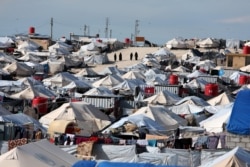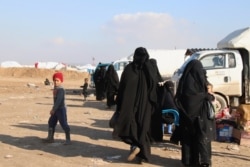The first Syrians to be released from the al-Hol displaced persons camp in the country's northeast are on their way home, raising new questions about security and their ability to integrate back into society.
The Autonomous Administration for North and East Syria (AANES) announced the departure of 289 people, mostly women and children, earlier this week as part of a renewed effort to clear out the overcrowded camp, which at times has been home to more than 70,000 people, including family members and supporters of the Islamic State terror group.
According to a statement from the Kurdish-led administration, the displaced Syrians are expected to return to their homes in al-Sha'fa and al-Baguz, in the Deir el-Zour countryside. It also said those released "have not been proven involved in hostilities and crimes against Syrians."
The AANES and the Kurdish-led Syrian Democratic Council, the political arm of the U.S.-backed Syrian Democratic Forces (SDF), first announced plans to send home many of the Syrians at the al-Hol camp last week, saying the situation was no longer sustainable.
Video posted to social media, which could not be independently verified by VOA, appeared to show some of the families preparing to leave al-Hol, lined up in front of bags of belongings, while a convoy of almost 40 fully loaded trucks idled nearby.
"Syrians who want to leave al-Hol should be able to return home," SDC Executive Committee President Ilham Ahmed said in a post to her Twitter account last week, promising a dignified return.
So far, the effort to start returning the estimated 24,000 displaced Syrians at al-Hol appears to be meeting with approval from the United States.
"We have discussed this with the SDC and understand what was conveyed about al-Hol does not signify a change in the process for Syrians to leave the camp, including security vetting," a U.S. State Department spokesman told VOA following the initial announcement.
"We see these return and reintegration initiatives for women and the large number of children as positive," the spokesperson said. "We have been very clear that the situation at al-Hol, despite the magnificent efforts of the SDC, is unsustainable."
U.S. officials also told VOA that even before this latest effort to help empty out al-Hol camp, SDC programs to return displaced Syrians to their homes have largely met with success, with 5,000 mostly women and children successfully returning to their homes.
They also praised a separate effort to hold to account Syrians who fought with the Islamic State terror group, reintegrating some of them back into Syrian society under the watchful eye of tribal elders.
But concerns persist, with some U.S. military officials voicing fears that al-Hol has already managed to serve as an incubator for a new generation of terrorists.
"It's not a good place to live," Gen. Kenneth "Frank" McKenzie, the commander of U.S. Central Command, told the United States Institute for Peace about al-Hol during an online forum this past August.
"Bad things are going to happen in terms of radicalization," he added. "I have yet to see a scheme that can deal with deradicalization at scale."
Other U.S. military officials also have said intelligence indicates some of the women kept at al-Hol were more than just the wives or daughters of IS fighters, but rather "fighters who just happen to be female."
Additionally, some Syrian tribal leaders have balked at taking in more people from al-Hol, noting the IS "ideology has still an impact in these women."
Officials with the Kurdish-led administration in northeast Syria say their current plans to relieve the overcrowding in al-Hol do not include releasing any residents with strong ties to IS, including the approximately 10,000 residents who are connected to IS foreign fighters.
But earlier this week, they did announce a general amnesty for Syrian nationals at al-Hol who are sick, over the age of 75 or who have been found guilty of what they described as less serious crimes, though details of the amnesty have yet to be finalized.
Still, some humanitarian workers expect it will be some time before large numbers of displaced Syrians are actually released.
"We're not going to be seeing overnight mass returns," an international aid official who is based in the region told VOA, speaking on the condition of anonymity due to security concerns.
Instead, the official said there likely will be a "speeding up" of the release of families for which the Kurdish-led administration already has secured tribal sponsorship agreements, mostly for those who came from the Deir el-Zour area.
The aid official said there are ongoing conversations between aid groups and Kurdish officials on how best to ensure a smooth transition.
"There are a number of different issues these families are going to be facing," the official said. "Many families are missing civil documents."
Other families are fearful of going home.
"They are worried about repercussions," the official told VOA. "Anyone who comes from al-Hol, there is an association with ISIS."














